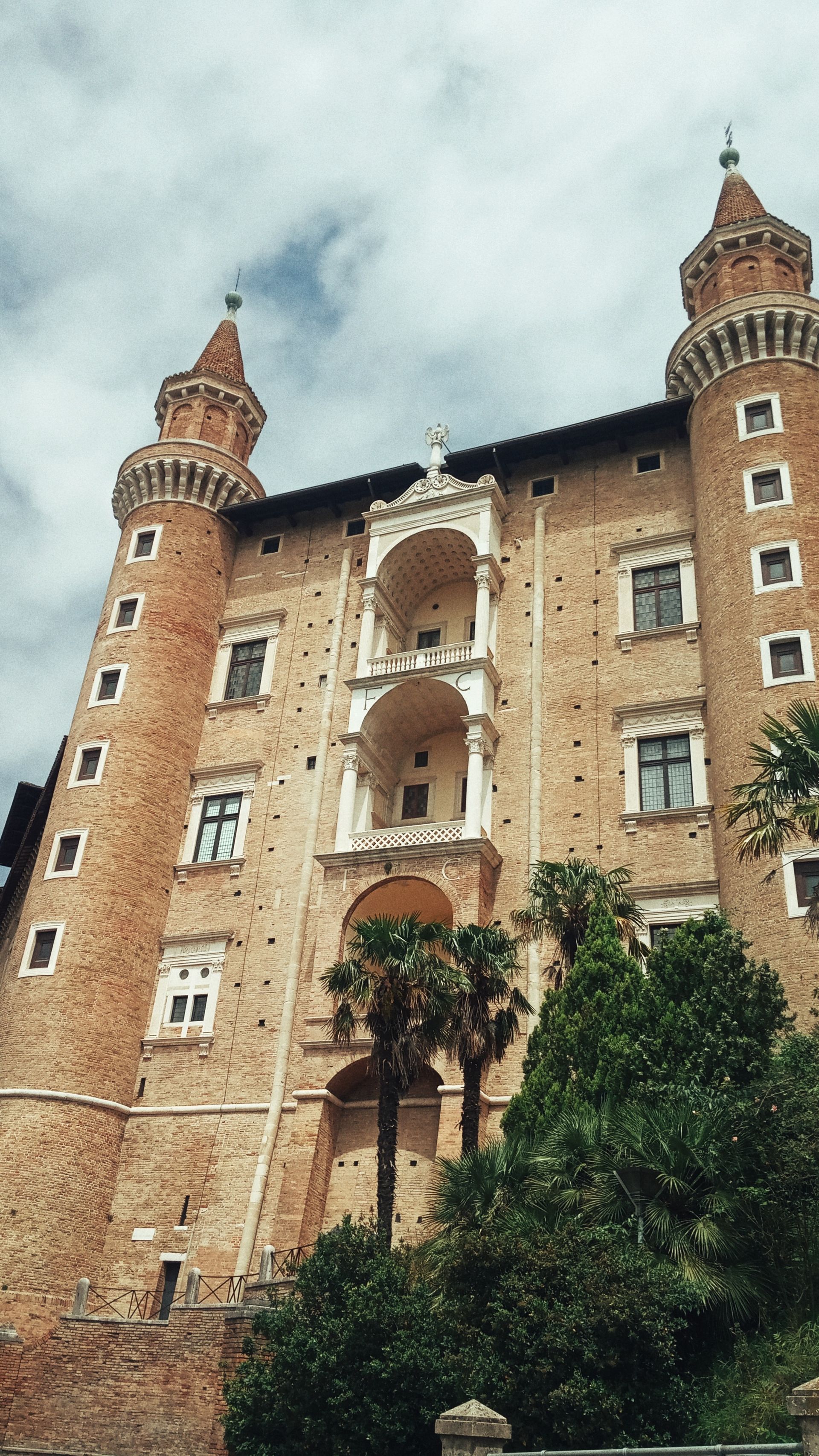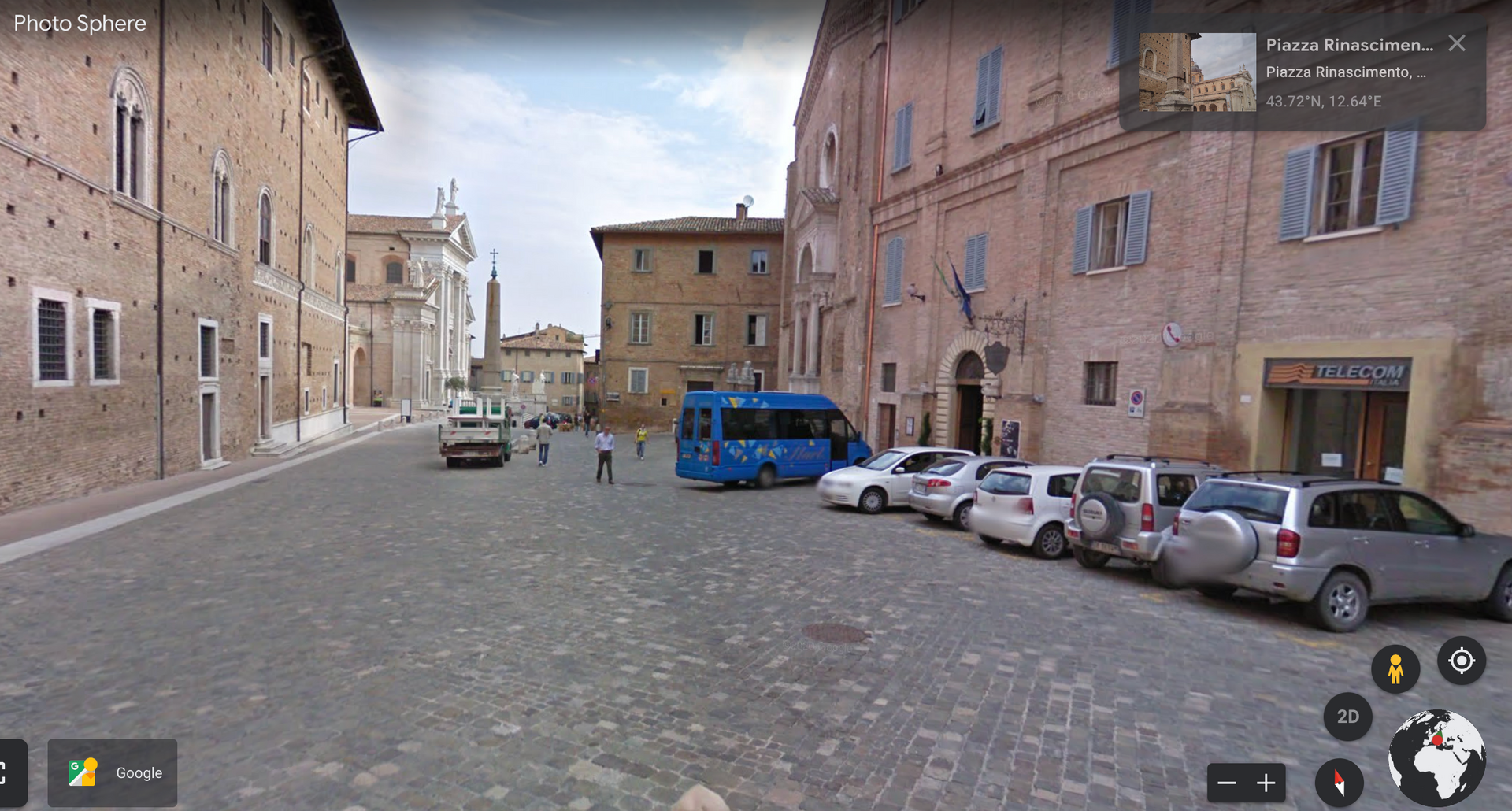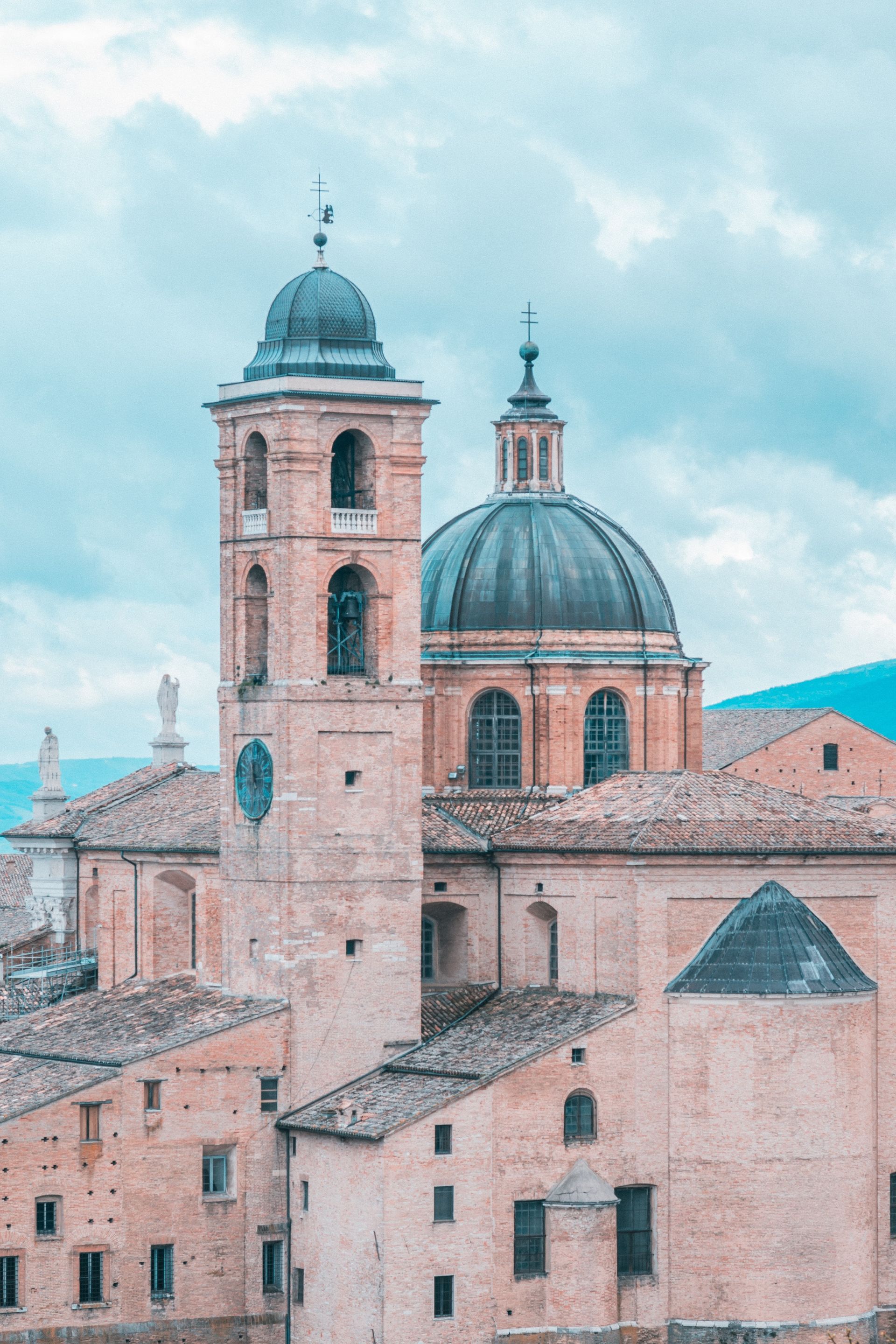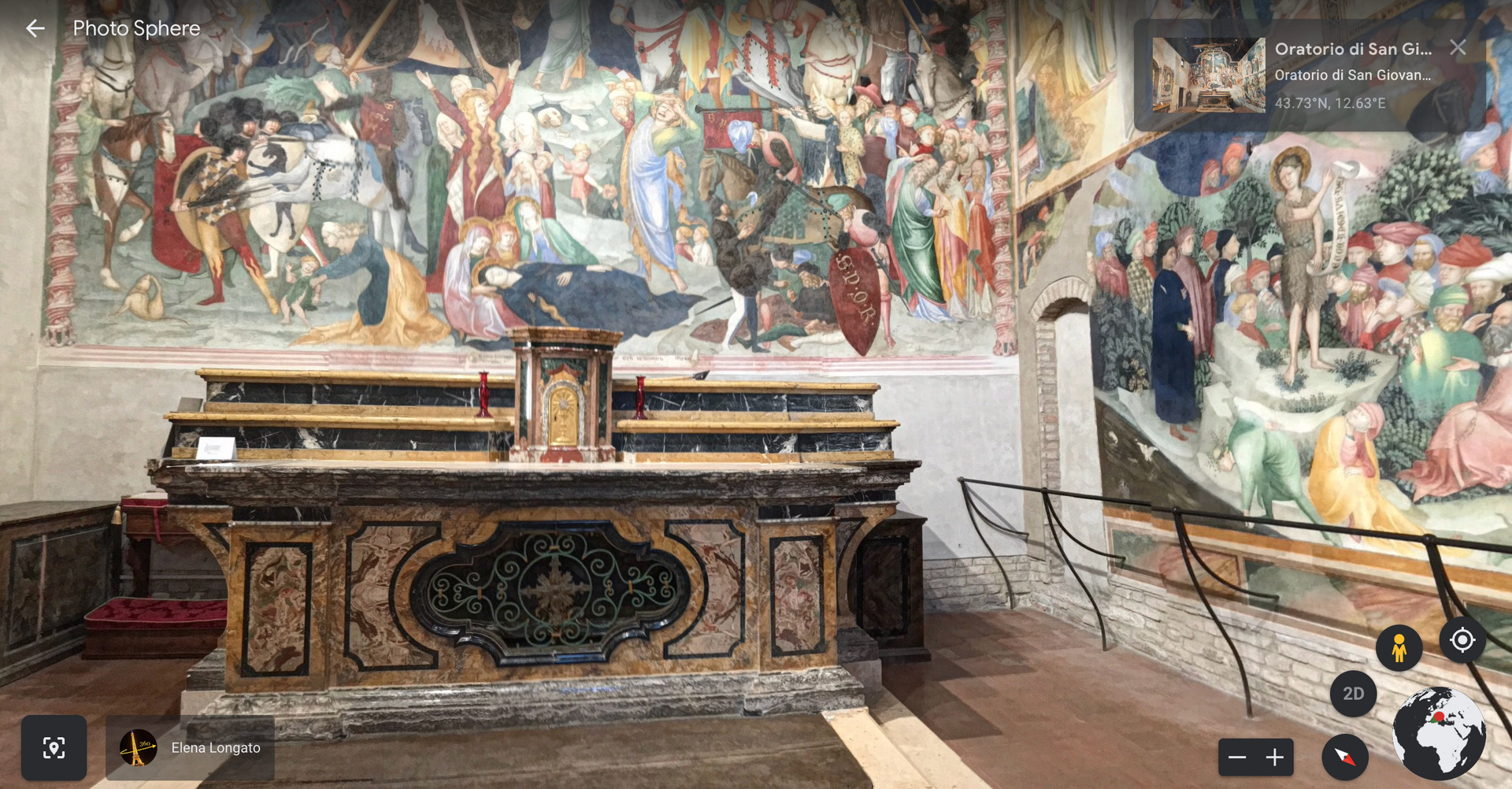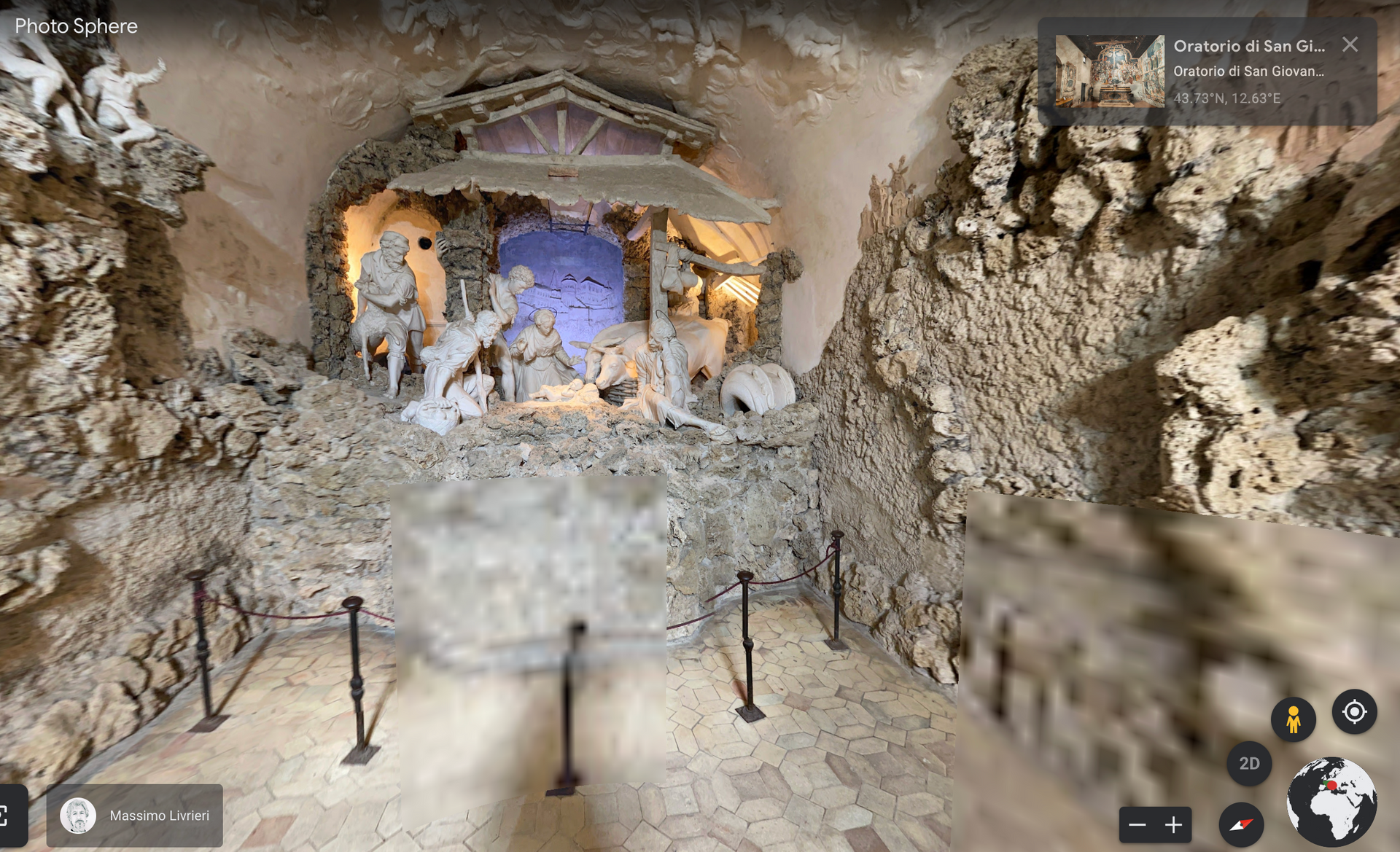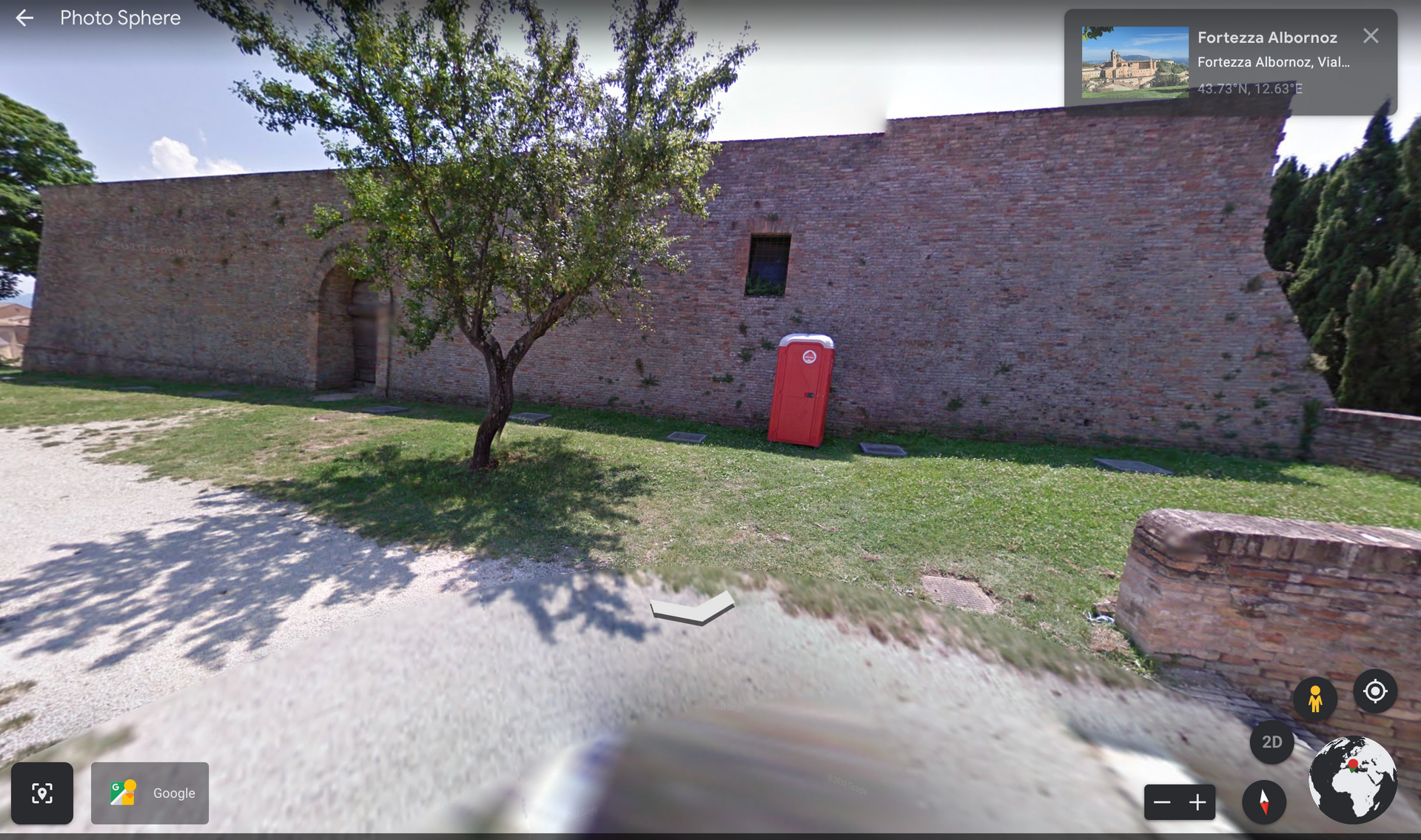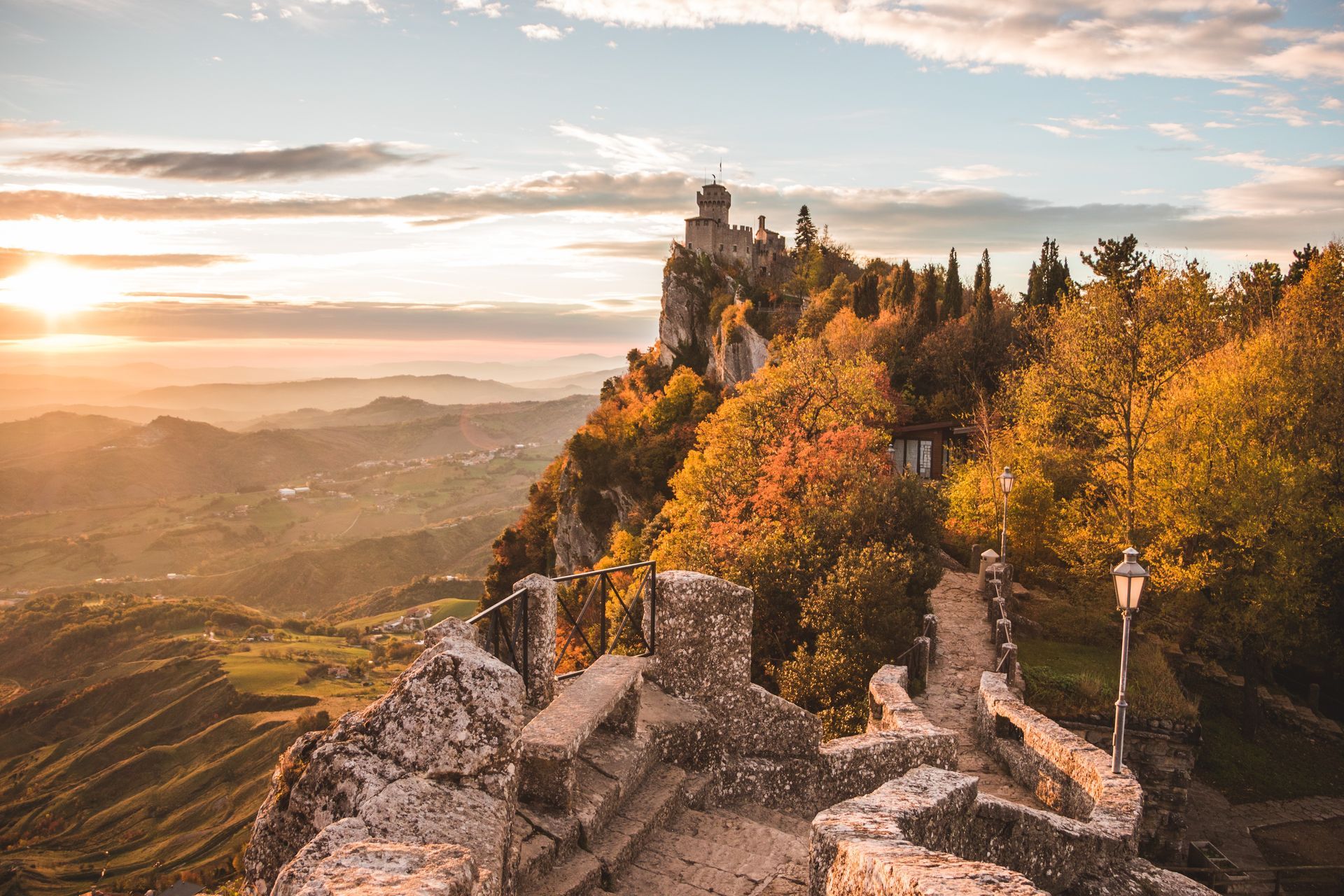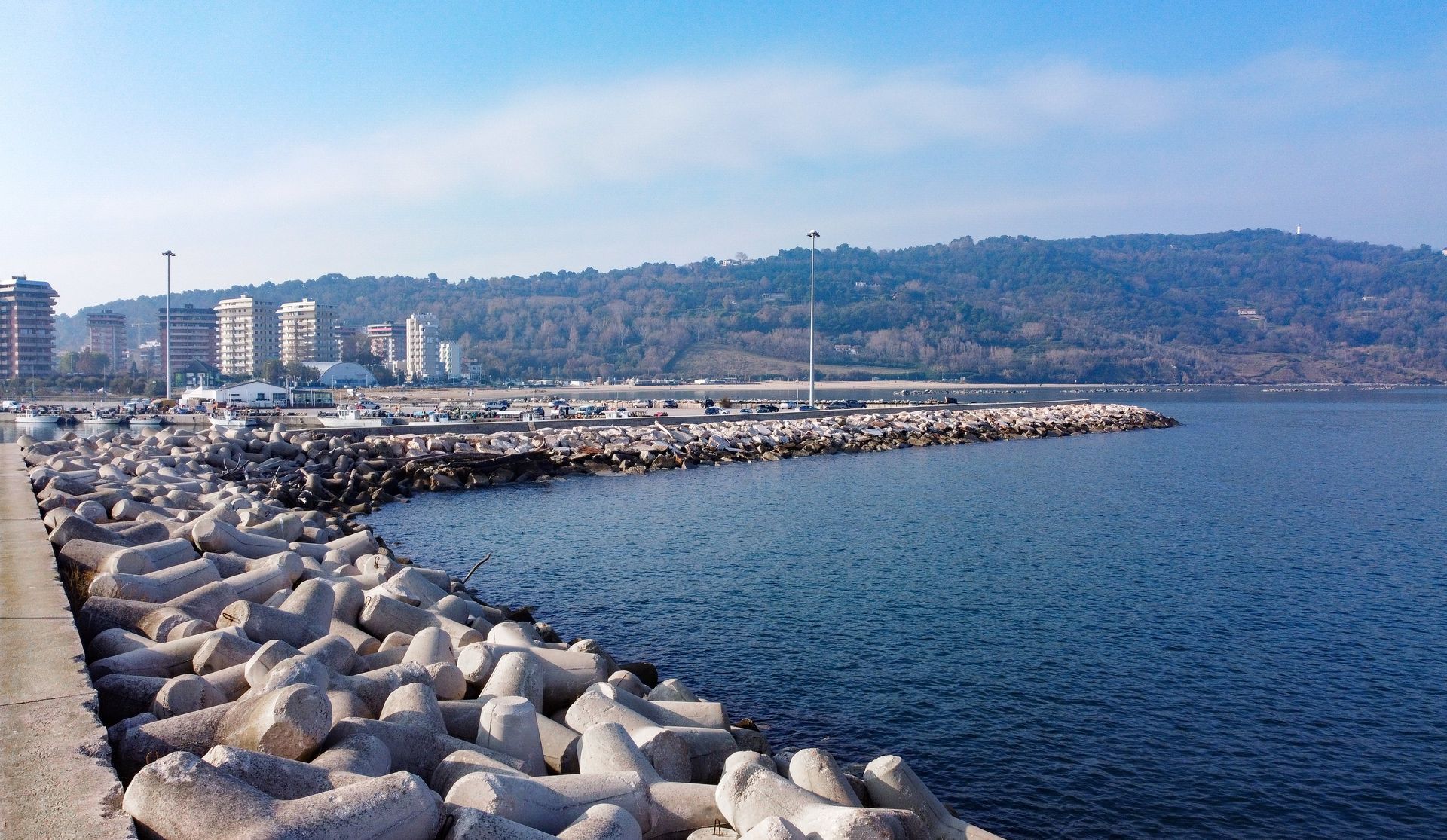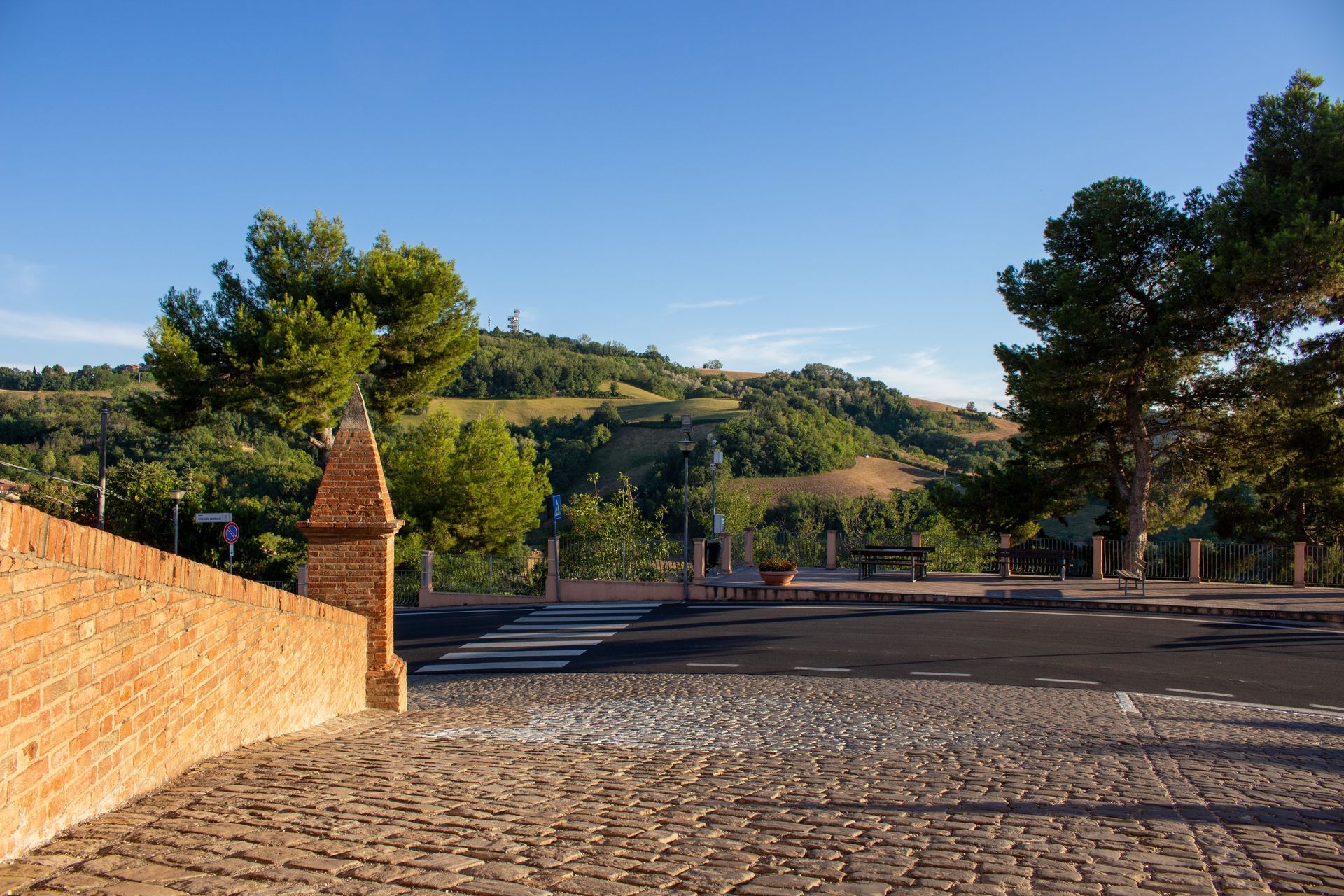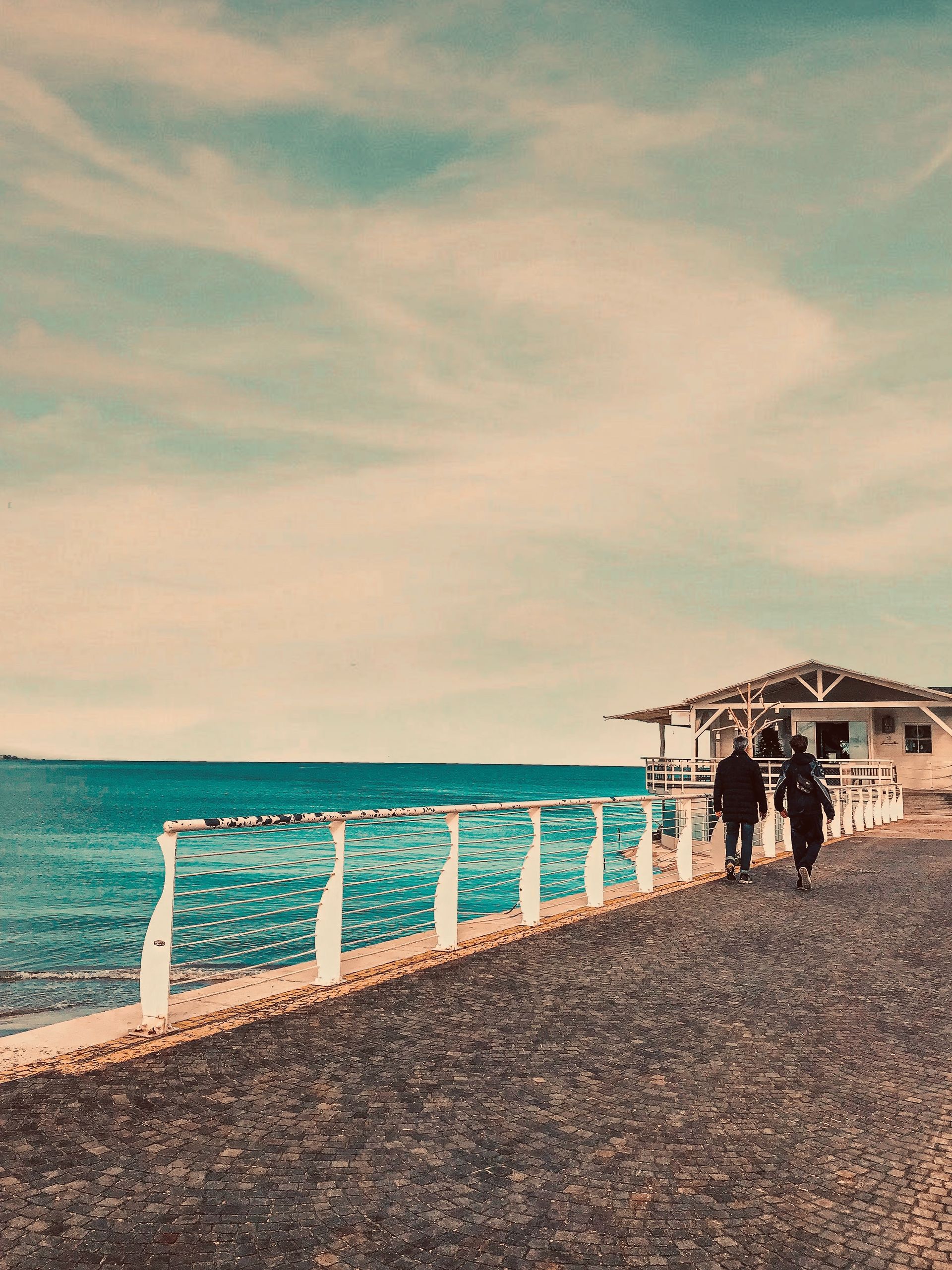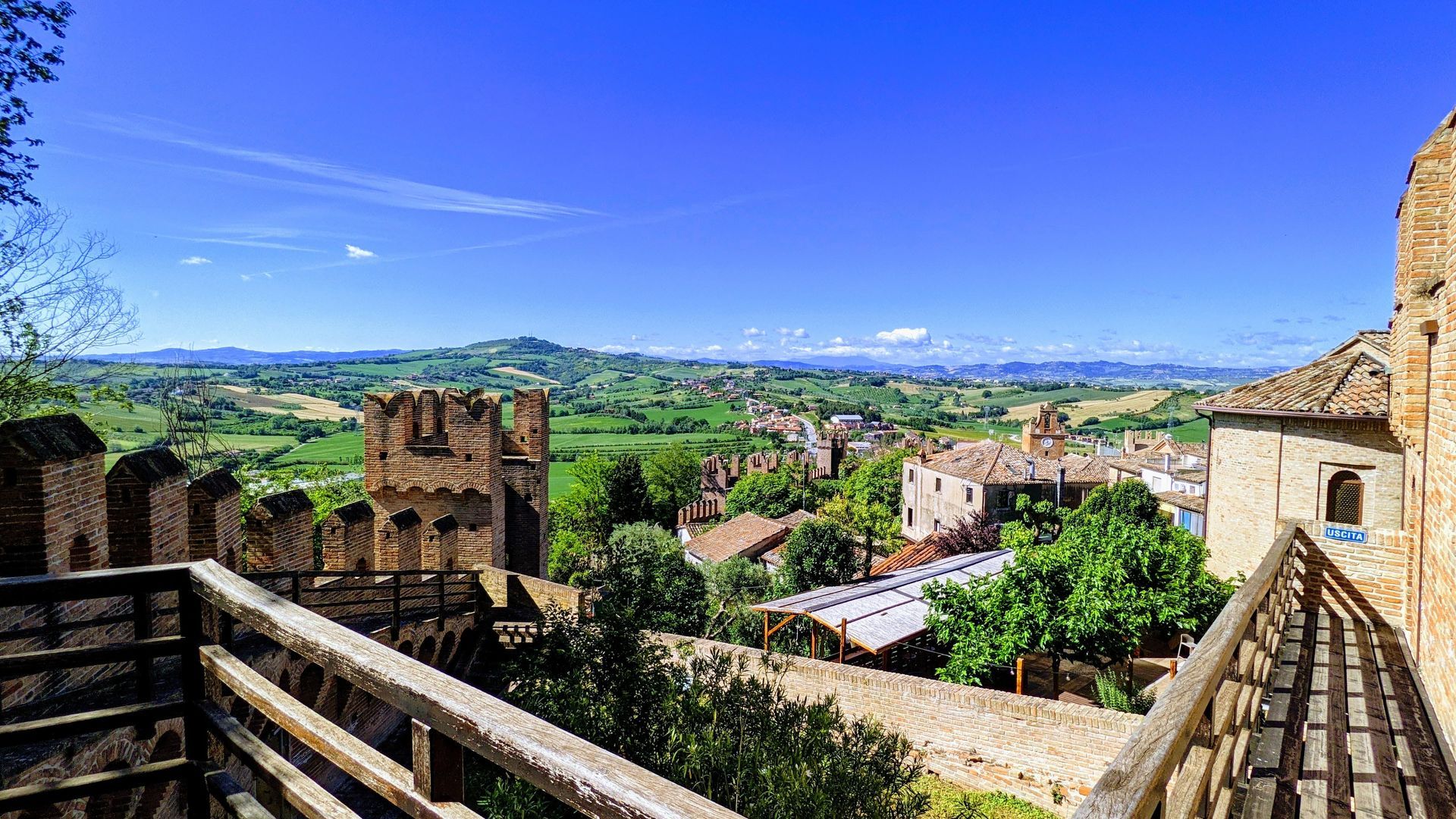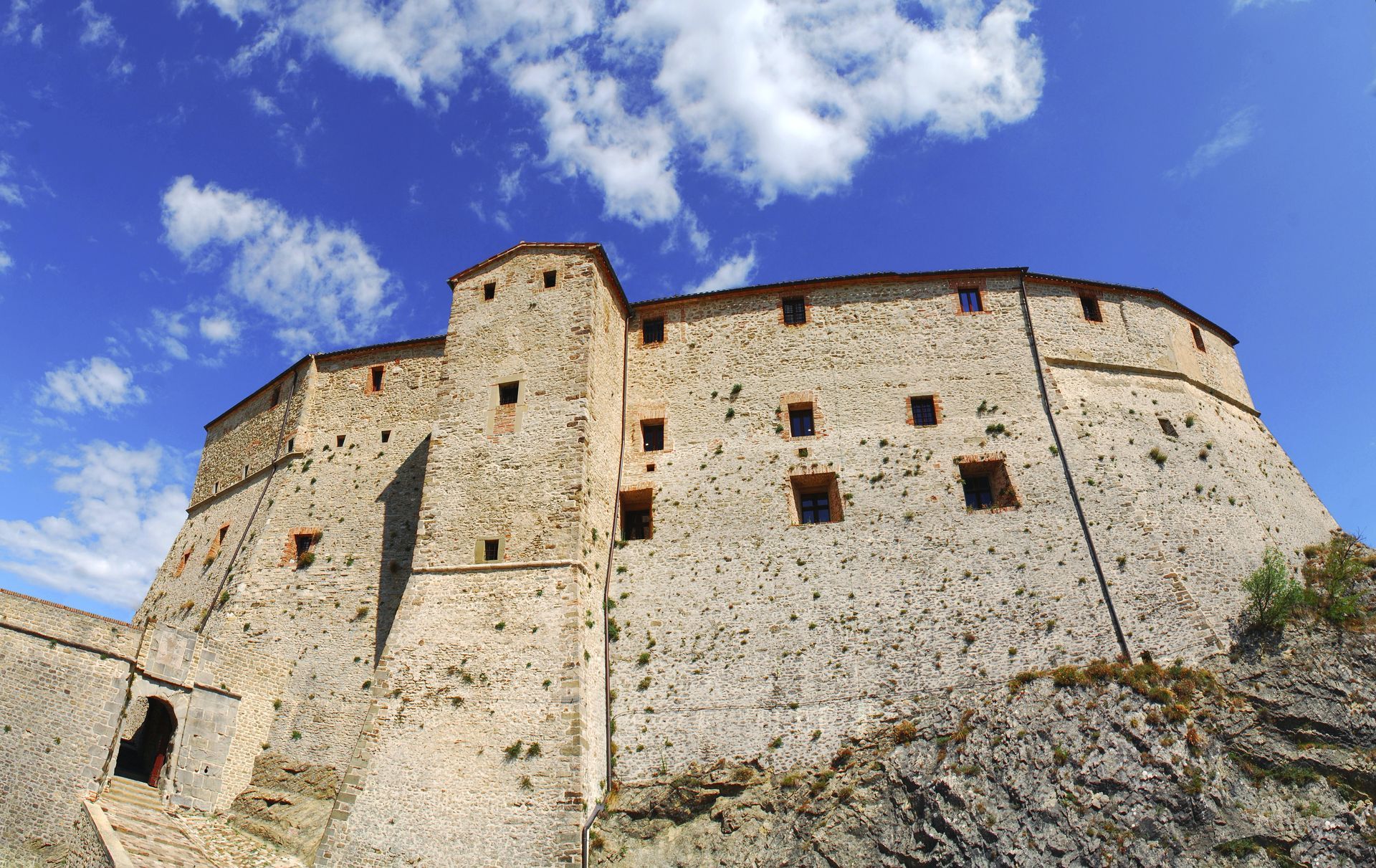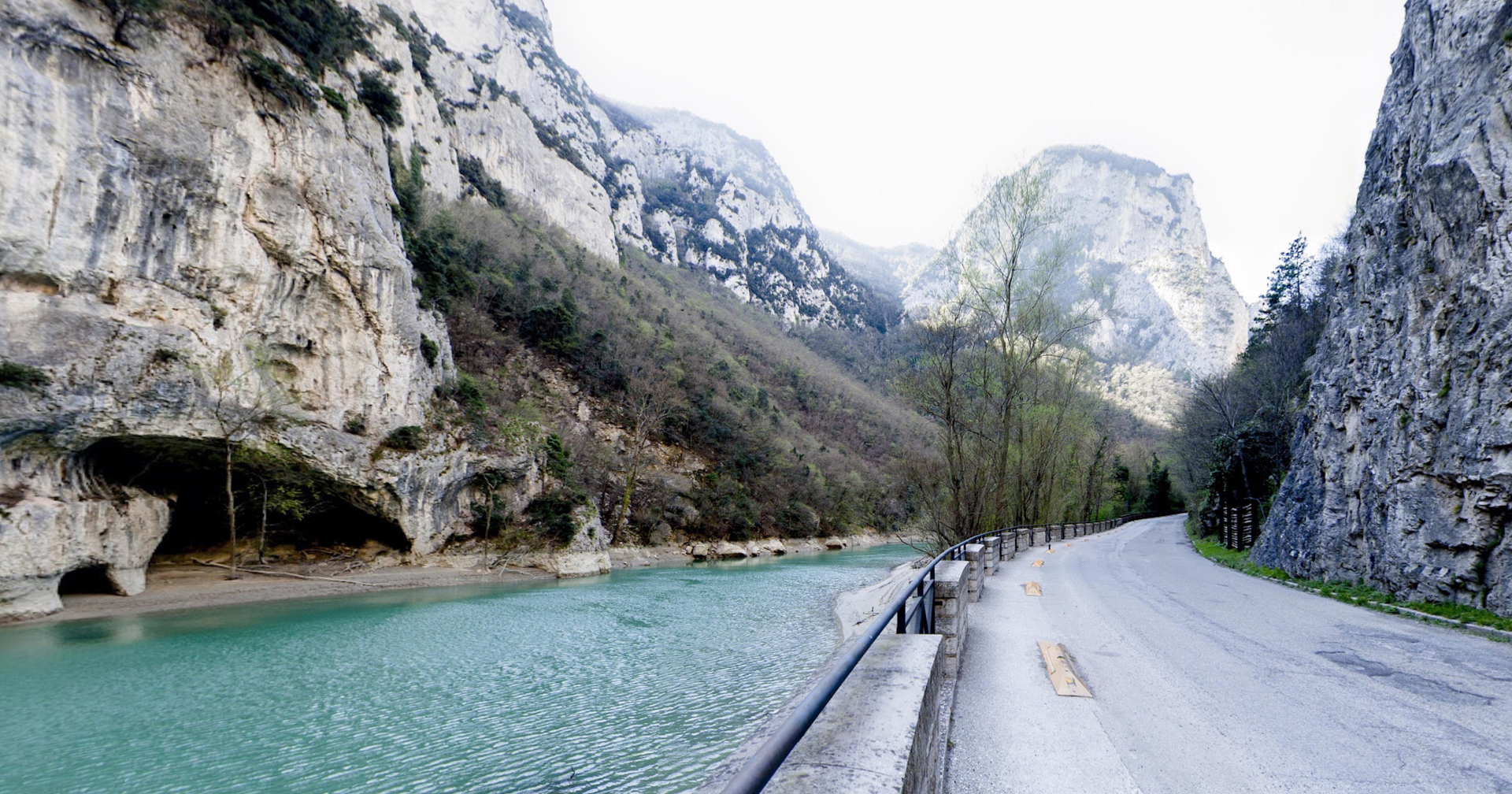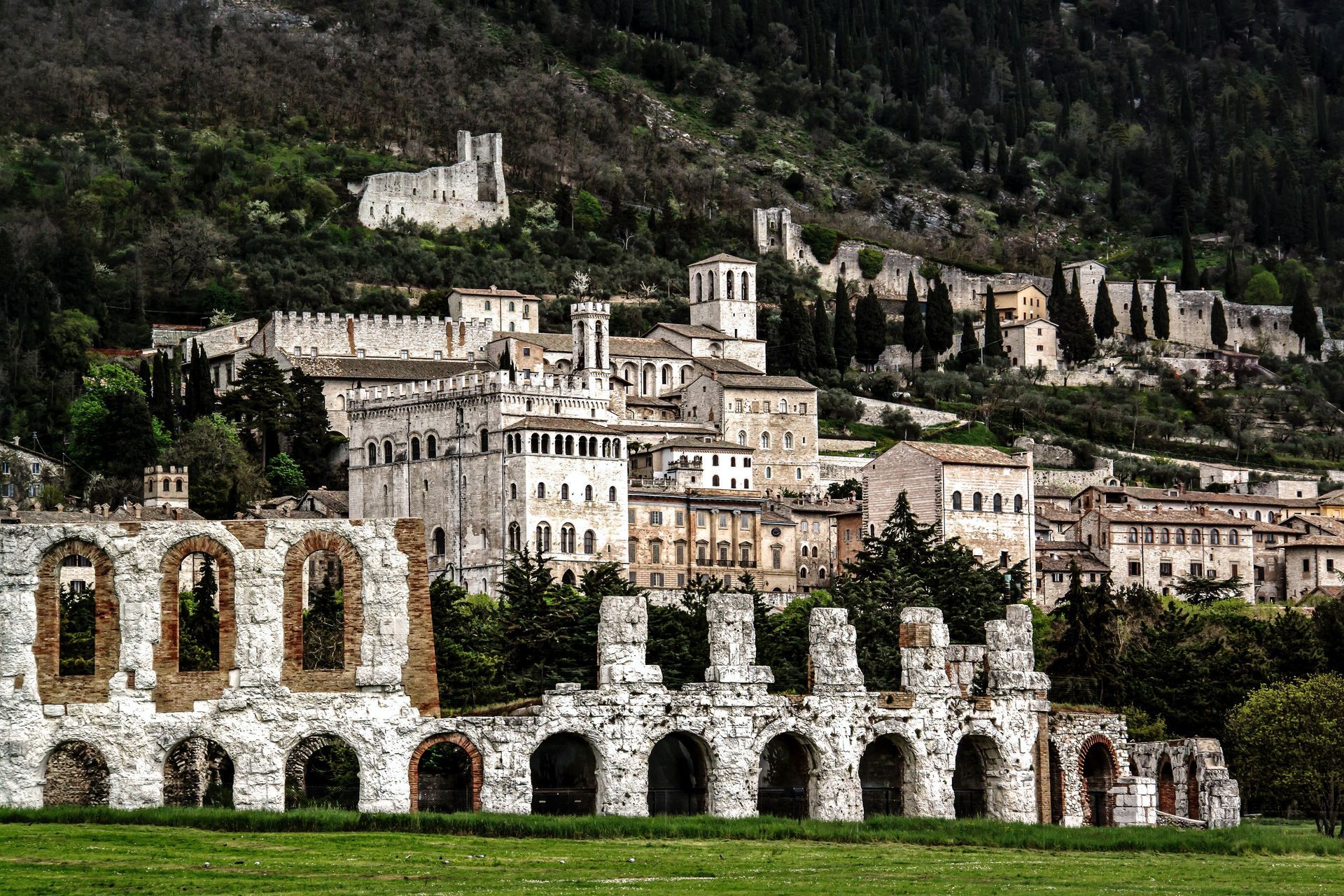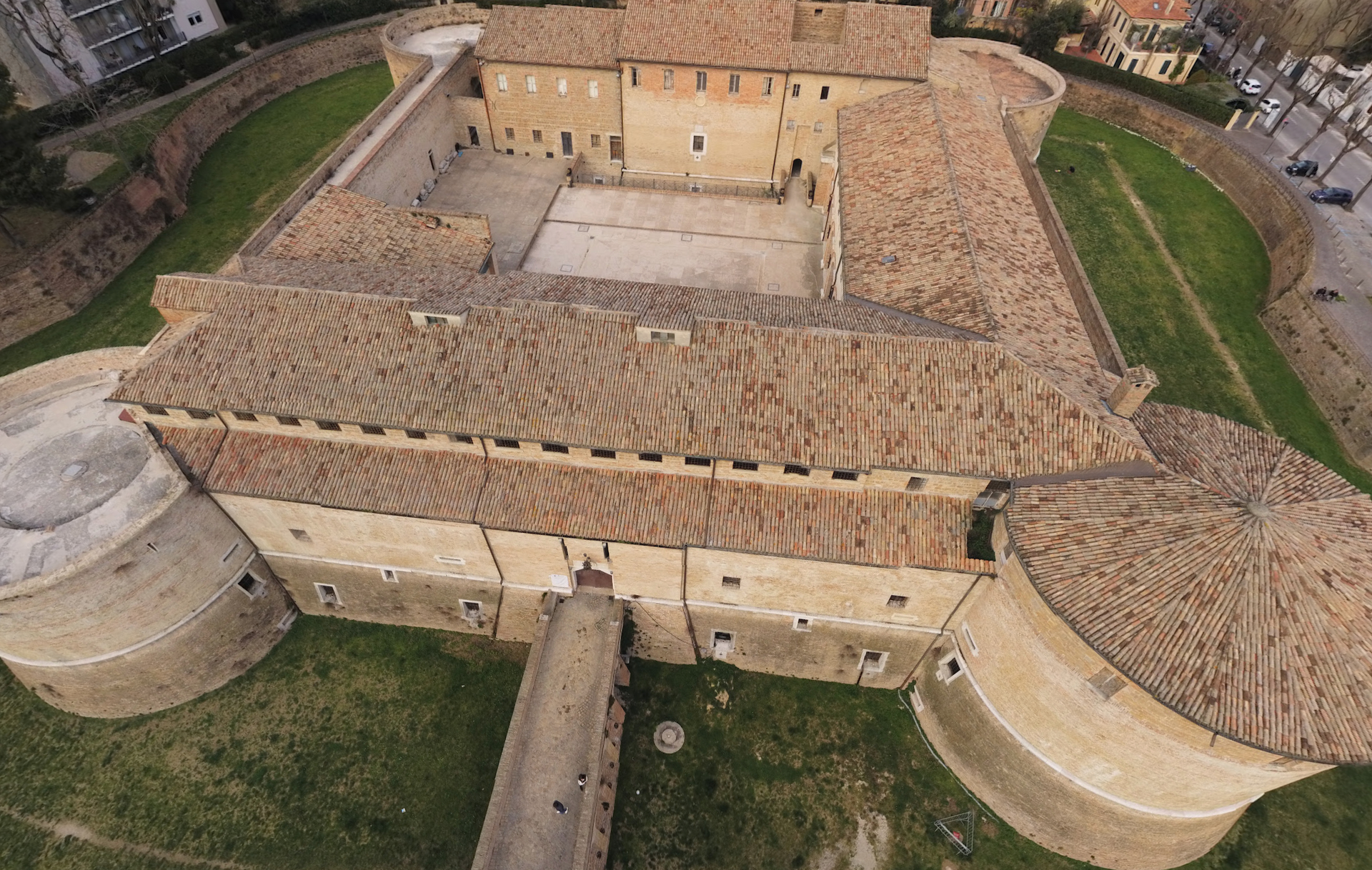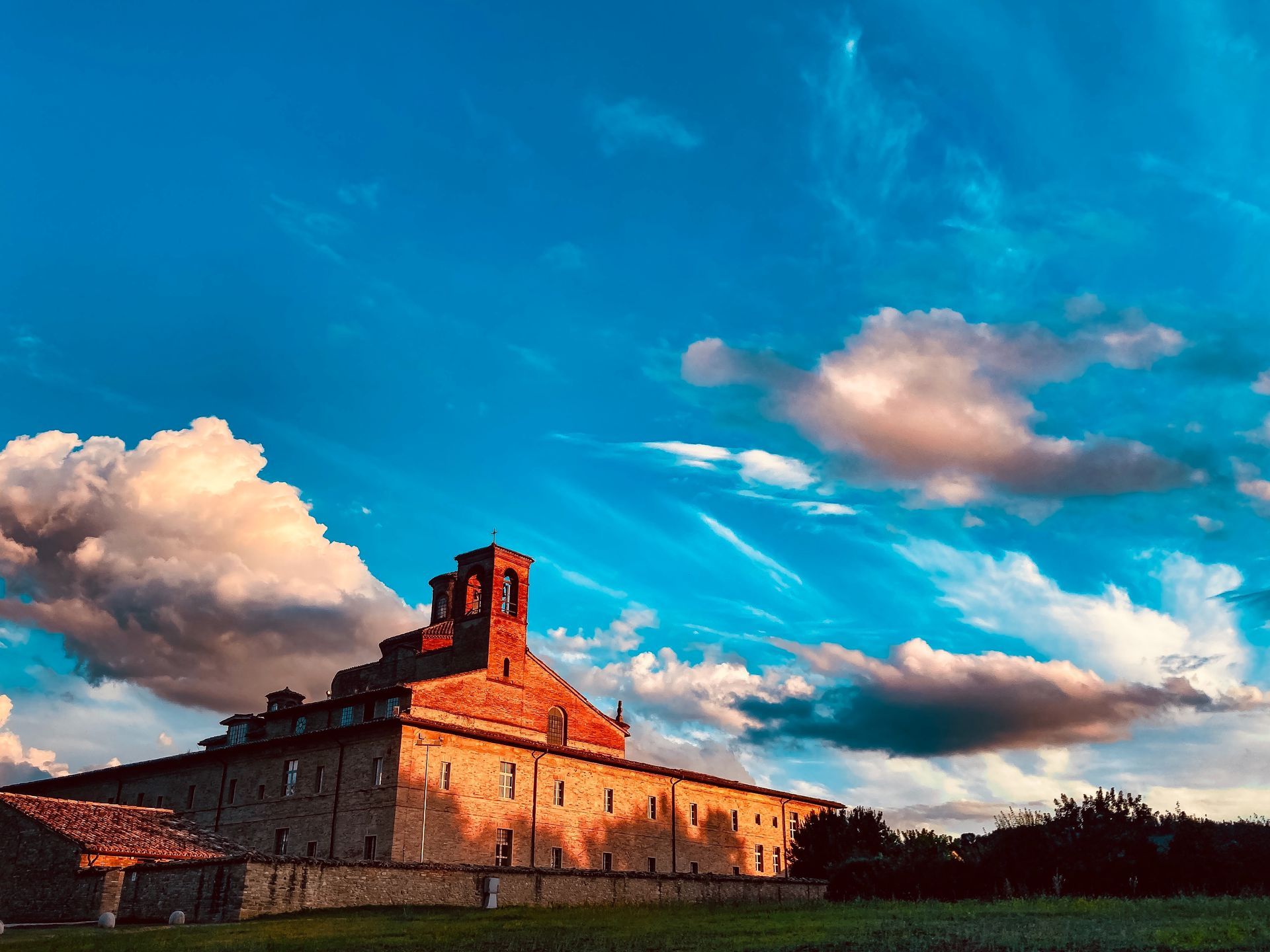Things to do in Urbino
Urbino, a captivating city with a legacy spanning Roman origins to a glorious Renaissance past, stands as a UNESCO World Heritage Site today. There are plenty of things to do in Urbino that showcase its rich cultural and artistic heritage.
Admire masterpieces in art galleries, explore architectural gems from the 15th century, and visit historical sites dating back to Roman times.
Take a step back in time at the Ducal Palace, once the residence of Duke Federico da Montefeltro.
Discover hidden treasures in its winding medieval streets and immerse yourself in the city's vibrant cultural scene. Urbino never ceases to amaze, offering a delightful journey through art, history, and architecture.
Ducal Palace
In Urbino, there are a plethora of things to do in Urbino, but one must not miss exploring the most important building, the Ducal Palace.
It is not just a palace but a small fortified town envisioned by Duke Federico da Montefeltro during the Renaissance era.
Admire the architectural marvel crafted by various skilled architects over 30 years, including Maso di Bartolomeo, Luciano Laurana, and Francesco di Giorgio Martini. Immerse yourself in history and culture as you wander through this "ideal city," once a meeting place for renowned artists who graced the court.
Don't forget to marvel at the engineering masterpiece, the bastion of the helical ramp, and the historic Raffaello Sanzio Theater, an integral part of Urbino's vibrant heritage.
Piazza del Rinascimento
When in Urbino, make sure to include the following things to do in Urbino itinerary.
Start by exploring the awe-inspiring Ducal Palace, home to the Marche National Gallery's Renaissance treasures by artists like Raphael and Titian.
Afterwards, head to Piazza del Rinascimento to admire the Gothic-style San Domenico church and the neoclassical Cathedral of Santa Maria Assunta.
These architectural marvels will immerse you in the city's rich history and artistic heritage. Urbino's charm lies in its blend of art, culture, and breathtaking surroundings, offering an unforgettable experience that celebrates the essence of Italian Renaissance beauty.
Urbino Cathedral
When visiting Urbino, there are several things to do in Urbino that you must not miss.
Begin by exploring the iconic Ducal Palace, now housing the Marche National Gallery with its exceptional collection of Renaissance masterpieces.
Admire works by Raphael, Titian, and Piero della Francesca. Afterwards, head to Piazza del Rinascimento to marvel at the Gothic-style San Domenico church and the neoclassical Cathedral of Santa Maria Assunta.
Don't forget to venture inside the cathedral to see Federico Barocci's breathtaking paintings.
Lastly, uncover the cathedral's intriguing caves, which have a rich history, from hosting a Confraternity to safeguarding precious art during World War II.
Urbino's cultural and artistic treasures await, offering an unforgettable journey through history and beauty.
Raphael’s House
When in Urbino, one of the must- things to do in Urbino is to visit the birthplace of Raphael Sanzio, one of the greatest artists of the Renaissance, born on March 28, 1483. Located in the artisan district, his childhood home offers a glimpse into the early life of this legendary painter.
Although the house retains only a few original works by Raphael, the visit is worthwhile to understand his artistic beginnings.
Raphael honed his skills in his father's workshop, and who served as an artist at the court of Federico da Montefeltro. Explore the ground floor with Giovanni Santi's workshop, now hosting temporary exhibitions, and ascend to the first floor to see copies of Raphael's paintings and tributes by other artists.
Admire the fresco in Raphael's bedroom depicting a "Madonna and Child," believed to be an early collaboration with his father. Exiting the House of Raphael, continue uphill to find the monument dedicated to this extraordinary artist, completing a rewarding journey through Urbino's artistic heritage.
Oratory of St John the Baptist
Among the things to do in Urbino, a visit to the Oratory of St. John is a must.
This historical building, dating back to 1365, initially served as a hospital for pilgrims, the sick, and penitents. Step inside to discover a captivating masterpiece adorning its walls – a cycle of frescoes created by the Salimbeni brothers from San Severino in the 15th century.
The frescoes in the Oratory of St. John portray scenes from the "Life of St. John the Baptist" and the "Crucifixion," highlighting the extraordinary accomplishments of international Gothic art in Italy.
The drama of Jesus' death contrasts with the fragmentation of the story into minor episodes, while the Stories of St. John on the altar's right wall exude a less dramatic tone. This enchanting artistic gem offers a unique insight into Urbino's cultural heritage.
Oratory of St John the Baptist
Among the things to do in Urbino, a visit to the Oratory of St. John is a must. This historical building, dating back to 1365, initially served as a hospital for pilgrims, the sick, and penitents.
Step inside to discover a captivating masterpiece adorning its walls – a cycle of frescoes created by the Salimbeni brothers from San Severino in the 15th century.
The frescoes in the Oratory of St. John portray scenes from the "Life of St. John the Baptist" and the "Crucifixion," highlighting the extraordinary accomplishments of international Gothic art in Italy.
The drama of Jesus' death contrasts with the fragmentation of the story into minor episodes, while the Stories of St. John on the altar's right wall exude a less dramatic tone.
This enchanting artistic gem offers a unique insight into Urbino's cultural heritage.
Botanical Garden of the University
One of the delightful things to do in Urbino is to explore its Botanical Garden, established in 1809 by Professor Giovanni De Brignoli as a scientific institution.
Spanning over 200 square meters and featuring three levels, the garden houses a collection of neoclassical-style greenhouses constructed in 1813.
Inside these greenhouses, visitors can marvel at an impressive array of 2,731 plant species and varieties, with 572 being indigenous to the region.
With its rich diversity and historical significance, the Botanical Garden offers a fascinating experience for nature enthusiasts and those seeking to delve into Urbino's scientific heritage.
Albornoz Fortress
A visit to the Albornoz Fortress is a must among the things to do in Urbino. Situated atop Mount S. Sergio, this fortified building dates back to the late 14th century, and its intriguing history includes various reconstructions and changes in ownership.
Connected to the city walls in the 16th century, it later became the property of the Discalced Carmelite fathers before resuming its military role during the Napoleonic era.
Today, the fortress boasts a rectangular layout with two semicircular towers and bastions, housing the Bella Gerit Museum. Inside, visitors can marvel at archaeological artefacts and explore a dedicated room showcasing war equipment used from 1300 to 1500.
Climbing to its elevated position rewards you with a breathtaking panoramic view of Urbino and the picturesque landscape beyond.
Urbino’s Panoramas
Urbino, during significant renovation, still managed to captivate me from the moment I arrived.
The imposing Ducal Palace, though partially obscured by scaffolding, evoked awe akin to the Petronas Towers in Kuala Lumpur.
However, the real treasure lies in Urbino's surprises. Perched high above the valleys of Le Marche, the town offers breathtaking vistas when you least expect them. While wandering through the hilly cobbled streets, I stumbled upon one panoramic view after another, thrilling me with each revelation.
For the ultimate panoramic experience, I ventured up the trail to Parco Della Resistenze.
The steep ascent might test your endurance, but reaching the top rewards you with a chance to catch your breath and bask in the awe-inspiring views.
Urbino's knack for surprising visitors with its enchanting panoramas truly sets it apart. In this charming hilltop town, every corner holds the promise of a new and exhilarating viewpoint, making it one of the most exciting things to do in Urbino.
Urbino Foods
To truly savour the essence of Urbino, indulge in its delectable cuisine, a perfect way to conclude your visit.
Situated between the sea and the Apennine mountains, the city offers a delightful array of dishes featuring mushrooms, truffles, and games, reflecting its diverse geographical influences. "Passatelli" stands out among the first courses.
At the same time, the beloved "Crescia," a Piadina-like delicacy, pairs perfectly with Montefeltro salami, Carpegna ham, and Fossa pecorino cheese, especially when accompanied by the ancient "Casciotta" cheese. For the main course, relish succulent beef, with the local Marchigiana breed offering extraordinary steaks.
From farm-fresh produce to regional delicacies, the culinary journey in Urbino will undoubtedly delight your taste buds, completing your experience of the city's rich heritage and traditions.
Exploring Beyond Urbino: Day Trips Full of Italian Charm
Situated in the scenic Marche region of Italy, Urbino is celebrated as a UNESCO World Heritage site, known for its abundant cultural legacy, historical importance, and valuable artistic heritage.
However, this charming city also serves as an ideal base for venturing out into the surrounding landscapes, offering a plethora of fascinating day trips for travellers seeking to explore the beauty and history of the region. Let's embark on a journey of discovery with day trips from Urbino.
Gubbio: A Medieval Gem
A mere hour's drive from Urbino, Gubbio is a picturesque medieval town that seems frozen in time. It boasts narrow cobbled streets, well-preserved medieval architecture, and the stunning Palazzo dei Consoli. Don't miss the chance to ride the Funivia Colle Eletto, a cable car offering panoramic views of the surrounding countryside.
San Marino: The Serene Republic
Approximately 90 minutes away from Urbino lies the Republic of San Marino, one of the world's oldest republics. Explore its quaint streets, visit the iconic Three Towers, and immerse yourself in the rich history and culture of this independent microstate while enjoying breathtaking vistas of the Adriatic coast.
Pesaro: Beachside Bliss
For those yearning for a taste of the Adriatic Sea, the coastal town of Pesaro is just a short drive from Urbino. Its beautiful sandy beaches, vibrant promenade, and cultural attractions like the Rossini Opera Festival make it a perfect destination for a relaxing day by the sea.
Urbino's Surrounding Countryside: Nature Retreat
While Urbino itself is nestled amidst rolling hills and picturesque landscapes, taking a drive through its surrounding countryside is a day trip in its own right. Explore the charming villages, vineyards, and lush greenery, and even stop for a wine-tasting experience at one of the local wineries.
Urbino's strategic location in the heart of the Marche region makes it an ideal starting point for a range of captivating day trips. Whether you seek history, culture, natural beauty, or seaside relaxation, the day trips from Urbino offer a diverse array of experiences that showcase the enchanting charm of Italy's Marche region.
What is Urbino, Italy Famous For? A Renaissance Jewel
Urbino, Italy, is a city that embodies the spirit of the Renaissance period. Nestled in the picturesque region of Marche, this historic city is renowned for its rich cultural heritage, artistic legacy, and architectural treasures. Let's delve into what makes Urbino a celebrated destination known around the world.
Renaissance Splendor
Urbino is primarily recognized for its affiliation with the Renaissance era. During the 15th century, it served as the epicentre of artistic and intellectual activity under the patronage of the Montefeltro family. The city's artistic heritage is most prominently represented by the Palazzo Ducale, a masterpiece of Renaissance architecture and a UNESCO World Heritage Site.
Birthplace of Raphael
One of Urbino's most celebrated claims to fame is being the birthplace of Raffaello Sanzio da Urbino, commonly known as Raphael. Raphael, one of the most influential artists of the Renaissance, left an indelible mark on the world of art with his masterful paintings and frescoes. The place of his birth, Casa Natale di Raffaello, has been transformed into a museum dedicated to his life and accomplishments, drawing art aficionados from around the world.
Historic University Town
Urbino is also known for its historic university, the Università degli Studi di Urbino "Carlo Bo." Established in the 16th century, it has a rich academic tradition and contributes to the city's vibrant intellectual atmosphere. The university's presence has made Urbino a hub for scholarly pursuits and cultural exchange.
Architectural Elegance
The city's architectural charm extends beyond the Palazzo Ducale. Urbino's well-preserved medieval and Renaissance architecture graces its winding streets and piazzas. The Cathedral of Urbino, with its distinctive façade, and the Oratory of San Giovanni Battista are just a few examples of the city's architectural treasures.
Cultural Festivals
Urbino is known for hosting cultural festivals that celebrate its heritage and artistic legacy. The Festa del Duca, a historical reenactment of life in Urbino during the Renaissance, transports visitors back in time. The Urbino Early Music Festival, dedicated to early music and instruments, draws musicians and music enthusiasts from all over.
Picturesque Landscape
The city's location amidst the rolling hills of Marche offers breathtaking views of the Italian countryside. The surrounding landscape, characterized by vineyards and olive groves, adds to Urbino's allure, making it a destination not just for art and history but also for natural beauty.
Culinary Delights
Urbino is known for its delectable regional cuisine. Visitors can savour dishes like Tagliatelle al Tartufo (truffle pasta) and Crescia, a savoury flatbread. The city's restaurants offer a delightful blend of traditional Marche flavours and Italian culinary artistry.
Urbino, Italy, is known for its rich Renaissance heritage, being the birthplace of Raphael, its historic university, architectural elegance, cultural festivals, picturesque landscape, and culinary delights. It's a city that beckons travellers to immerse themselves in its artistic, intellectual, and cultural legacy, making it a must-visit destination for those seeking to explore Italy's cultural treasures.
Places to visit near Urbino Italy
Nestled in the picturesque region of Marche, Italy, Urbino is a charming and historic town known for its rich cultural heritage and stunning Renaissance architecture. While Urbino itself is a treasure trove of art and history, there are several equally captivating Places to visit near Urbino Italy. From enchanting hilltop villages to natural wonders, here are some must-visit destinations to consider during your trip to Urbino.
Gola del Furlo Nature Reserve
For nature enthusiasts, the Gola del Furlo Nature Reserve is a true gem. Just a short drive from Urbino, this reserve offers a breathtaking natural landscape. Explore hiking trails that lead you through lush forests, along the scenic Metauro River, and towards the awe-inspiring Furlo Gorge. This sanctuary is also inhabited by a variety of wildlife, making it a perfect location for birdwatching and capturing wildlife through photography.
San Leo
San Leo, perched on a rocky outcrop, is a medieval village that seems frozen in time. The village is famous for its remarkable fortress, providing sweeping vistas of the surrounding countryside. Wander through the charming streets, visit the Pieve Cathedral, and learn about the history of this enchanting town, which was once the prison of the famous Italian adventurer and writer, Cagliostro.
Gubbio
Gubbio, often referred to as the "City of Stone," is another nearby destination that promises an unforgettable experience. Known for its well-preserved medieval architecture and picturesque setting in the Apennine Mountains, Gubbio offers a glimpse into Italy's rich history. Don't miss the opportunity to ride the funicular to the Basilica di Sant'Ubaldo for stunning views and explore the Roman Theater.
Rocca Constanza
Within Urbino itself, be sure to visit Rocca Constanza. This ancient fortress stands as evidence of the town's significance during the Renaissance period. Within the fortress, there is a museum where you can delve into the history of Urbino and appreciate its architectural splendour.
From the tower, you can enjoy panoramic vistas of Urbino and the surrounding region.
Pesaro
If you're seeking a dose of coastal charm, head to Pesaro, a lovely seaside town on the Adriatic coast. Take a leisurely walk along the promenade, unwind on sandy beaches, and explore the Rossini Opera Festival, a tribute to the renowned composer Gioachino Rossini, who was born in Pesaro.
The town is also home to a variety of museums, including the Civic Museums of Palazzo Mosca, showcasing local art and history.
Parking in Urbino
Parking in Urbino: A Comprehensive Guide
When visiting the historic town of Urbino in Italy, finding suitable parking can be a crucial aspect of your trip. Urbino's charming streets and historical sites are best explored on foot, and parking options are available to ensure a hassle-free experience. This guide aims to furnish you with vital details about parking in Urbino, encompassing areas, charges, and suggestions for a smooth visit.
On-Street Parking in Urbino
On-street parking in Urbino is available, but it can be limited, especially in the town centre where the streets are narrow and winding. If you plan to park on the streets, be prepared for a challenge during peak tourist seasons when spaces are in high demand. Keep these tips in mind:
- Blue Zones: Look for blue lines painted along the curb, as these indicate paid parking zones. To park in these zones, you'll have to acquire a ticket from a nearby ticket machine or an authorized vendor.
- Time Limits: Pay attention to posted signs for time limits. Certain regions may impose limitations on the duration of your parking.
- Parking Disc: In some areas, you may need to display a parking disc on your dashboard to indicate your arrival time. These discs are typically available at tobacco shops or newsstands.
Parking Lots and Garages
To avoid the challenges of on-street parking, consider using parking lots and garages in Urbino. These facilities provide more convenience and peace of mind during your visit. Some options include:
- Parcheggio Mercatale: Located near the town centre, this parking area is a convenient choice for exploring Urbino's historical sites. It is a paid parking lot with hourly rates.
- Parcheggio Porta Santa Lucia: Another centrally located option, this parking lot is near the historic city walls. It offers both hourly and daily rates, making it suitable for short visits or longer stays.
- Parcheggio Porta Valbona:
This parking garage is situated outside the town walls but is still within walking distance of the city centre. It provides a secure and covered parking option.
Parking Fees and Regulations
The charges for parking in Urbino can fluctuate based on where you park and how long your stay is. Be prepared to pay in euros, and keep small changes on hand for ticket machines. Rates are typically reasonable and designed to encourage the turnover of parking spaces. Always check posted signs for the latest parking regulations and fees.
Tips for a Smooth Parking Experience
- Arrive Early: To secure a parking spot in a desirable location, arrive in Urbino early in the day, especially during peak tourist seasons.
- Use Public Transportation: Consider using public transportation to reach Urbino, as it can alleviate parking concerns and help reduce traffic congestion in the town centre.
- Follow Parking Etiquette: Be respectful of local parking regulations and fellow drivers. Illegally parked cars may be towed or fined.
While parking in Urbino can pose some challenges, it's a manageable aspect of your visit with proper planning and awareness of the available options. Utilizing parking lots and garages, understanding the regulations, and arriving early are key strategies to ensure a smooth and enjoyable exploration of this beautiful Italian town.
Palazzo Ducale Urbino
The Palazzo Ducale in Urbino, Italy, stands as an exquisite testament to the Renaissance era's artistic and architectural brilliance. This magnificent palace, often referred to as the Ducal Palace, is not only a historical treasure but also a UNESCO World Heritage Site. Explore its rich history, stunning architecture, and the cultural significance it holds.
A Renaissance Jewel
Palazzo Ducale Urbino, constructed in the 15th century under the patronage of Duke Federico III da Montefeltro and designed by the renowned architect Luciano Laurana, is a masterpiece of Renaissance architecture. It showcases the principles of symmetry, proportion, and classical influence that define the era.
Architectural Grandeur
One of the palace's defining features is its imposing facade, characterized by a harmonious blend of classical and Renaissance elements. The use of local pink and grey stone further enhances its visual appeal. As you approach the palace, the grandeur of the central courtyard, with its double loggias, creates a sense of awe.
Artistic Heritage
Inside the Palazzo Ducale, visitors are greeted by an art and culture treasure trove. Inside the palace, you'll find the Galleria Nazionale delle Marche, which features a remarkable assortment of Renaissance masterpieces. Among its highlights is the renowned "Flagellation of Christ" by Piero della Francesca, a work celebrated for its artistic and mathematical precision.
The Studiolo of Federico
One of the most intriguing rooms within the palace is the Studiolo of Federico da Montefeltro, the duke who commissioned much of the palace's construction. This intimate chamber is a testament to his scholarly pursuits and love for the arts. The intricate wooden intarsia panels depict a wide range of subjects, from mathematical instruments to mythological scenes, revealing Federico's multifaceted interests.
The Courtyard of Honour
The Courtyard of Honour is a central space within the palace, featuring a grand staircase and a harmonious fusion of architectural elements. It served as the setting for important ceremonies and events during the Renaissance period. Nowadays, it offers a captivating window into history and presents breathtaking panoramic vistas of Urbino.
A UNESCO World Heritage Site
In 1998, Palazzo Ducale Urbino was recognized as a UNESCO World Heritage Site, affirming its status as a cultural and historical treasure of global significance. Its inclusion on this prestigious list underscores its architectural and artistic importance, making it a must-visit destination for travellers and art enthusiasts alike.
Palazzo Ducale Urbino is a true Renaissance marvel that transcends time. Its architectural splendour, artistic heritage, and historical significance offer a profound glimpse into the cultural richness of the Renaissance period. Exploring this extraordinary palace is not just a voyage through time; it's also a deep dive into the enduring heritage of art and architectural excellence.
Urbino serves as an excellent base for exploring the diverse attractions near this historic town. Whether you're interested in nature, history, or simply soaking up the local culture, the Places to visit near Urbino Italy, provide a rewarding experience for travellers of all interests. From natural wonders to medieval villages, each destination offers a unique glimpse into the beauty and heritage of the Marche region.
FAQs -Things to do in Urbino
Got a question? We’re here to help.




